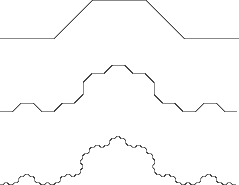One of the original applications for these graphs is in "empirical networks". Suppose you discover the ruins of several ancient Mayan cities in the central American jungle. Which pairs of cities should you expect to be connected by roads? The exact answer depends on the details of history, but you can make a guess based on the facts that people will tend to travel between every pair of cities, and don't tend to go too far out of their way. So if the shortest route from city x to city y passes near some other city z, people will likely stop there, but otherwise they are likely to go directly from x to y. In other words, we can model the likely set of roads by something like a beta-skeleton. Obviously this idea would be useful in designing new networks as well as in predicting the patterns of old ones.
So how good a road network do you get if you use the beta-skeleton?

Not very good at all!
The fractal curve depicted above defines sets of points for which the beta-skeleton is just the curve itself. In other words, the road network consists of a single road with cities strung out along it, much like Highway 99 in central California. But unlike Highway 99, the road is not very straight. If there are n cities, the length of the curve (relative to the distance between its endpoints) is proportional to a power of n determined by the curve's fractal dimension. The figure above works for some particular values of beta, but by making the fractal flatter we can perform a similar construction for arbitrarily small beta.
So the dilation of this network, a factor relating distance in the network and Euclidean distance, is non-constant. In terms of the original road network problem, if you use a beta-skeleton road network, you can be forced to travel many times further than the true distance "as the crow flies".
[From "Beta-Skeletons Have Unbounded Dilation". For other ways of constructing networks with better dilation, see my survey "Spanners and Spanning Trees".]
From the Geometry Junkyard,
computational
and recreational geometry.
David Eppstein,
Theory Group,
ICS,
UC Irvine.
Last update: .